The explosion of demand for mobile data and value-added services is overwhelming today’s mobile networks with rapidly escalating capacity challenges. Network operators need to re-evaluate how they approach the new complexities of servicing the demands of the expanding mobile marketplace. The days of the traditional access/aggregation/core network hierarchy in the mobile backhaul must give way to an emerging paradigm—heterogeneous networks (HetNets). Holistic HetNet Hauling (3H) organizes the entire HetNet’s wireless hauling requirements, including backhaul and fronthaul, and allows network operators to meet accelerating demand for cost-effective capacity under rapidly evolving network conditions. 3H is the blueprint for mobile network operators to understand and take advantage of the new technologies in order to meet the escalating demand for capacity.
The Strain on the Traditional Mobile Network
Since the days of GSM and CDMA (2G), mobile networks have been built with the access/aggregation/core paradigm. Subscribers access the network at the edges and their voice and data are collected at adjacent base stations. These base stations are backhauled to larger aggregation points and, finally, onto the core network.
The proliferation of smartphones, tablets and video applications puts a strain on the traditional network starting at the edges where subscribers access it. Where network operators used to deploy macro cells to provide network coverage, they now deploy them to address capacity. In order to accommodate the demand for capacity, operators are extending the edges of their network into smaller niches where smartphone users congregate. These small cell extensions need to work under the umbrella of existing macro cells and must be backhauled onto the rest of the network.
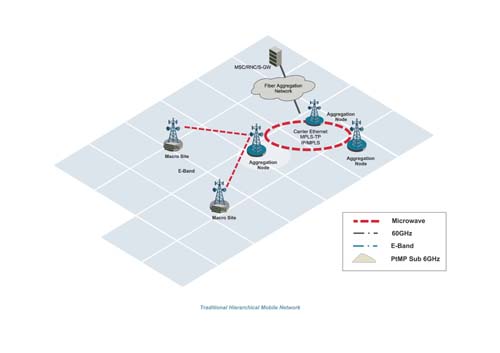
Traditional Hierarchical Mobile Network
The Rise of the HetNet
New technologies like LTE-A, C-RAN and small cells hold the key to solving mobile network operators’ formidable challenge of providing enough capacity to ensure good subscriber experience. Operators are now free to fashion all sorts of novel deployment scenarios that meet their capacity challenges cost-effectively. The adoption of these technologies will change the traditional network into a heterogeneous network (HetNet), a network that will host a variety of new deployment scenarios—no longer just access/aggregation/core—for delivering voice and data.
The HetNet Continuum
In the HetNet Continuum, operators have six new deployment scenarios to consider for meeting capacity demand. Three of these concern new small cell deployment and three deal with the evolution of the macro cell.
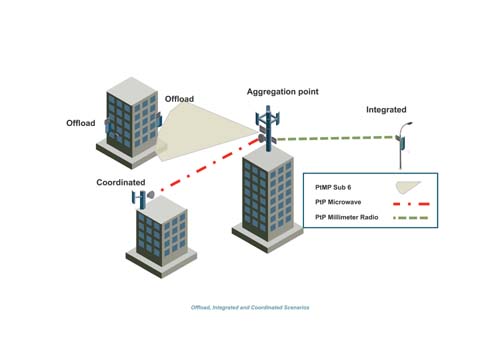
The HetNet Continuum
Small Cell Scenarios
In order to extend the capabilities of their existing base stations and to create additional capacity exactly where they need it, operators are adopting small cell technologies. For small cells to be effective, they must co-exist with the macro cell layer with consideration of interference mitigation.
Small cells have unique hauling challenges. Deployed in quantities at street level, primarily in urban environments, each small cell needs to be backhauled to a nearby macro cell or to some other point of aggregation. In many cases, fiber deployment is not practical, so small, inexpensive, microwave solutions with an emphasis on spectrum re-use and radio power are necessary. Non-line-of-sight and point-to-multipoint microwave solutions can efficiently backhaul the traffic of groups of small cells to the nearest or most efficient aggregation point like an already-existing macro cell.
1. WiFi Offload
Requiring very little from the backhaul in terms of capacity and latency, WiFi Offload leans toward low-cost, wireline backhaul solutions, unlicensed spectrum or even self-backhaul solutions.
In this scenario, we use existing WiFi technology and its extensive deployment to carry the capacity required by users, mostly for indoor coverage in public areas, enterprises and residential areas. WiFi is a low-cost, best-effort method that all devices support. New standards (IEEE 802.11u) allow for seamless user experience with mobile networks. Additional spectrum offered in IEEE 802.11ac/ad will only improve its usability.
2. Integrated Small Cells – 3GPP or WiFi
An integrated small cell is usually unidirectional, smaller and of lower emission than a macro cell. It can use licensed and unlicensed spectrum. There should be tight integration with the mobile network that handles roaming, handovers and billing. Emerging WiFi integration concepts enable interoperation with 3GPP-based small cells.
Availability and latency requirements are stricter and capacity requirements are higher for integrated small cells compared with the WiFi Offload scenario described above. Operators who deploy small cells also tend to invest more in the backhaul to guarantee acceptable user experience.
3. Coordinated Small Cells
Ongoing coordination between the small cell layer and the macro cell layer is perceived as one of the key drivers for wider adoption of small cells since, in many cases, uncoordinated small cells require separate spectrum channels to avoid interference, reducing the overall capacity gain.
LTE-A brings a new notion of coordination to small cell deployment allowing for efficient, dense deployment. The capability of small cells to coordinate their work with the macro cell layer means much better spectrum utilization, thus requiring fewer cells to provide more capacity especially at the edge of the cell. Coordination comes with very strict backhaul service level requirements in terms of latency, capacity and availability.
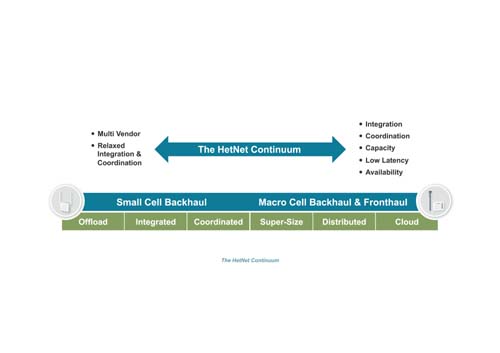
Offload, Integrated and Coordinated Scenarios
Macro Cell Backhaul and Fronthaul Scenarios
Though it seems that much of the industry commotion today is around small cells, it is actually the macro cell environment that is experiencing the most innovation. Capacity and OPEX pressures are leading to a new breed of solution development where space lease and acquisition, power consumption and site visits have increasing influence.
Macro cells experience a surge in capacity demand due to LTE-A carrier aggregation as they start to act as a hub for small cells. We identify three types of macro cell scenarios: Super-Size, Distributed and Cloud.
4. Super-Size Macro Cell
The evolution of urban tail sites, from 2G and its single Radio Access Technology (RAT) to Multi-RAT including 2G, 3G and 4G, was followed by the introduction of more efficient and software-defined digital units. These sites are forecast to evolve into small hub sites. If we add spectrum re-farming trends (reuse of 2G or 3G spectrum for LTE), carrier aggregation and overall capacity in the small cell network aggregated to this location, it is easy to see that the traditional tail site is evolving into a mini-aggregation site with great capacity demands toward the network core.
This super-sized capacity cannot be handled by E1/DS1 multiples anymore, nor can it be satisfied by Fast Ethernet. If, in early LTE-ready backhaul deployments, it was considered future-proof to target 100-200 Mbps of capacity for tail sites, now it is clear that the new capacity target should guarantee 300 Mbps to 1 Gbps of backhaul throughput.
5. Distributed Macro Cell
Distributed macro cells are a complementary approach to the super-size macro cell. But instead of aggregating uncoordinated small cells or even working in coordination with these small cells, in this scenario, small cells are part of the BTS and are defined as pico Remote Radio Units (pRRU). The interface between the base station and the radio unit is CPRI. In this scenario, instead of three to six sectors in a macro cell, we move to a model of ten to thirty sectors per BTS. This technique may be used to provide efficient indoor coverage and also for better outdoor coverage moving the new sector (pRRU) to a better location at a distance from the original macro site.
The backhaul requirements are similar to the Super-Size Macro Cell scenario, however, the pRRUs need some sort of fronthaul solution in order to connect to the macro site. While traditionally, radio units (RUs) and digital units (DUs) use fiber to connect from tower-top to the base, it is easy to see that, in an urban environment that requires crossing the street to get better coverage with the RU, deploying a fiber connection can be a prohibitively intensive and costly process. Microwave offers flexible solutions in many such cases.
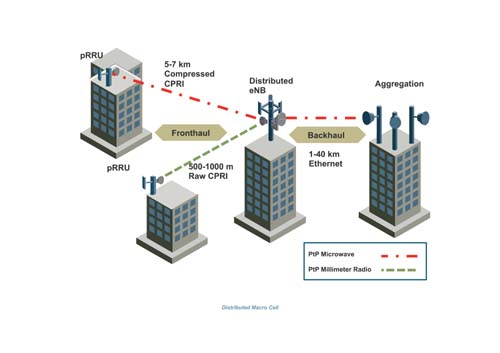
Distributed Macro Cell
6. Cloud/Centralized C-RAN
C-RAN is a new concept where the distributed macro cell is taken to the extreme. Think about covering a large city with a dozen large BTS sites and thousands of RUs. Backhaul is a non-issue in this case as those sites already become part of the mobile operator’s core.
This scenario demands a significant fronthaul effort based on optic fiber to carry the multiples of CPRI interfaces across the city, so, this scenario is more relevant for mobile operators with abundant fiber assets. However, even the best equipped mobile operators will not be able to cover 100% of their sites with fiber. To maintain 100% coverage and to enjoy the benefits of C-RAN, we have to consider new, non-fiber fronthaul deployment models. Compression techniques and higher capacity microwave and millimeter-wave radios provide the solution for the strict service level requirements in terms of latency and error tolerance.
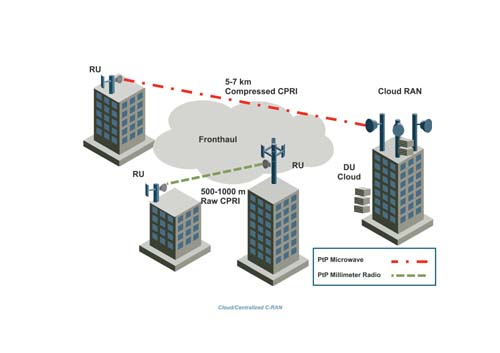
Cloud/Centralized C-RAN
Holistic HetNet Hauling (3H)
The access/aggregation/core network architecture is too rigid and expensive to cope with increasing mobility and demand for mobile data. To provide the appropriate capacity exactly where it is needed, mobile network operators require an holistic approach with a portfolio of flexible and cost-effective solutionsto implement hauling solutions for each scenario that they deploy.
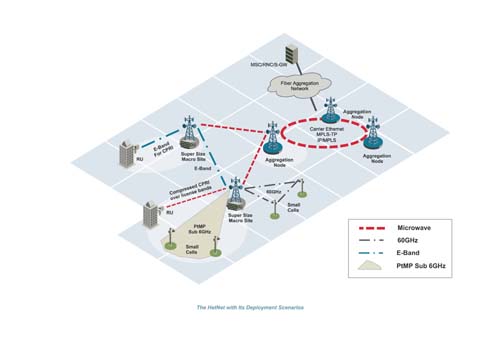
The HetNet with Its Deployment Scenarios
